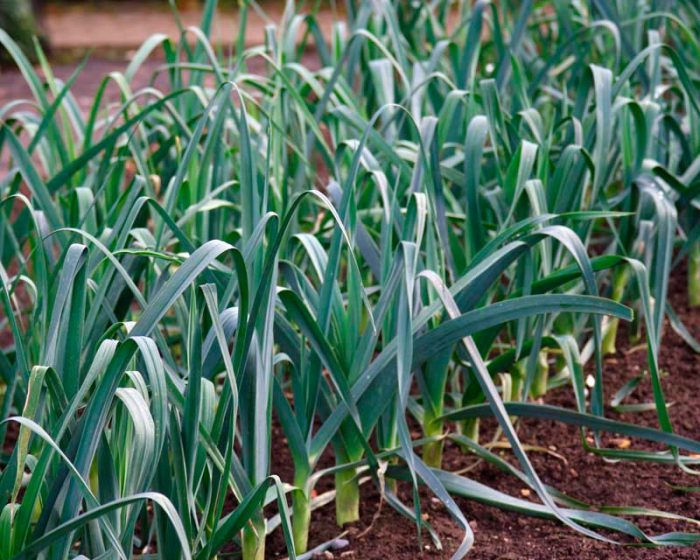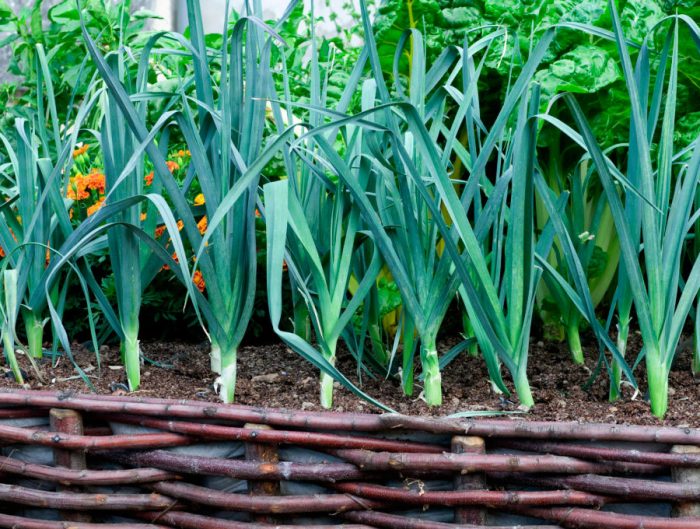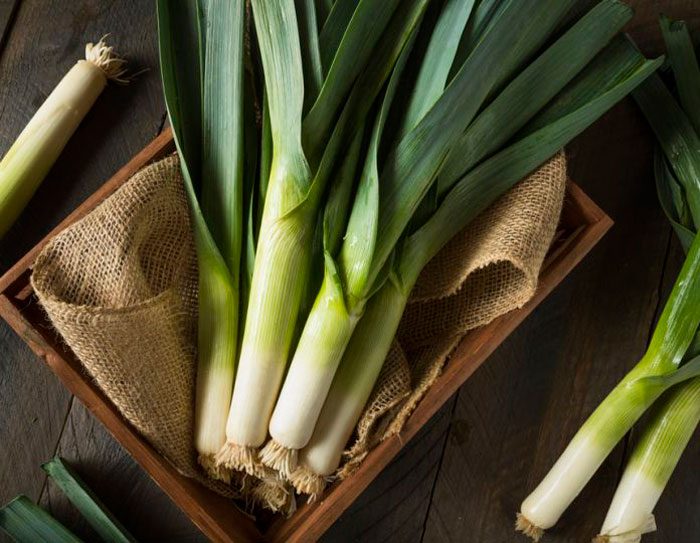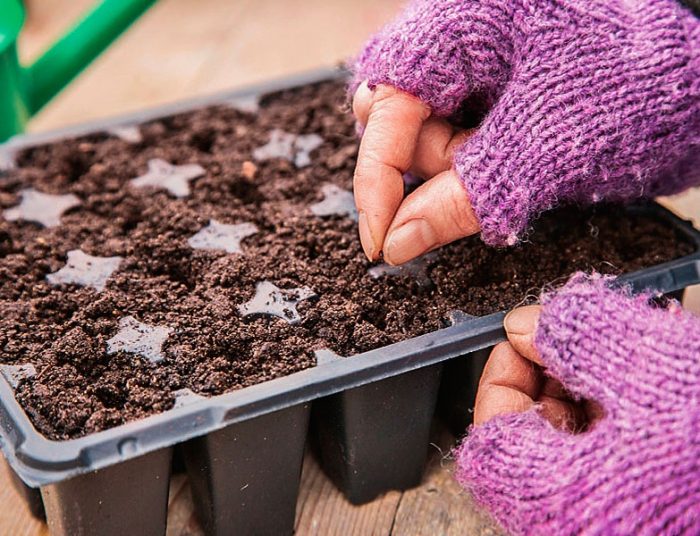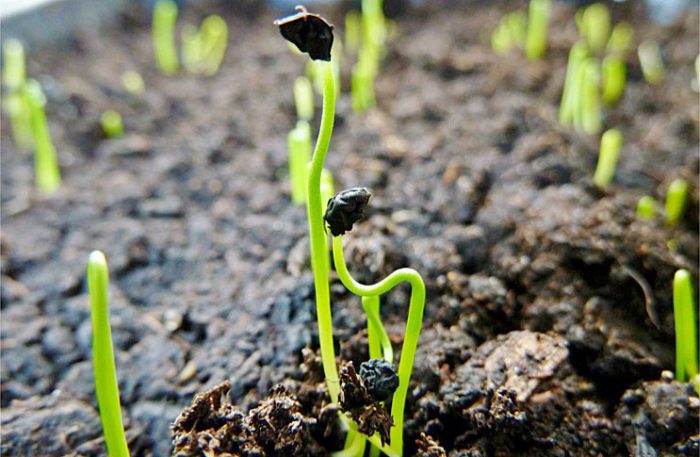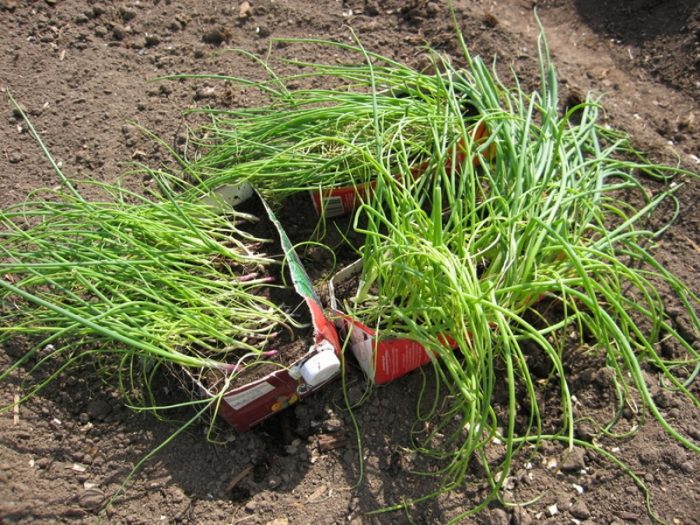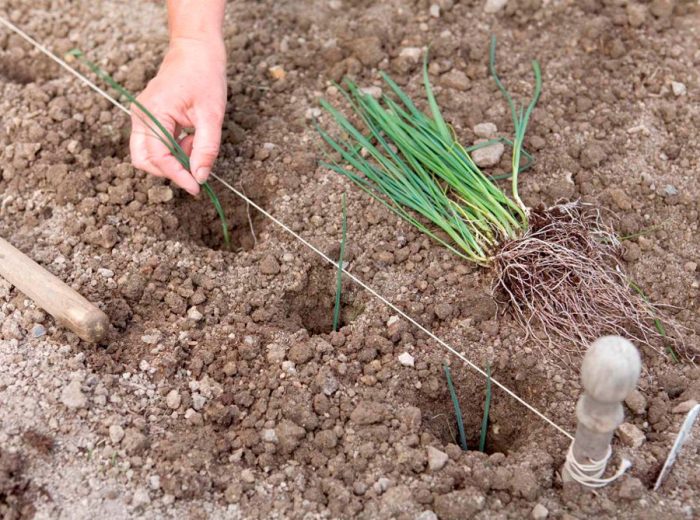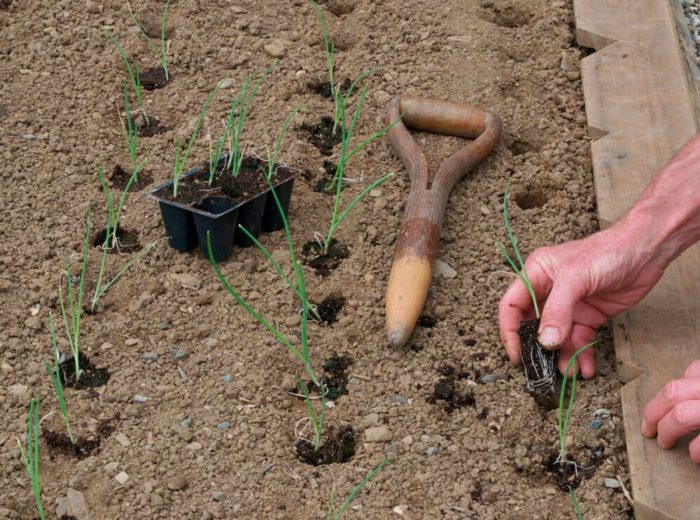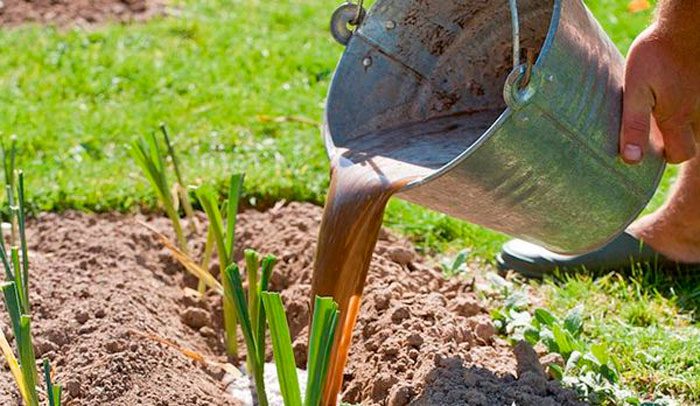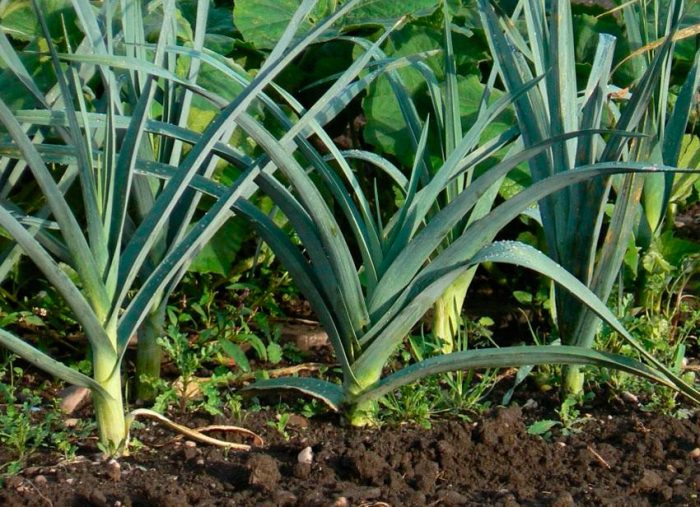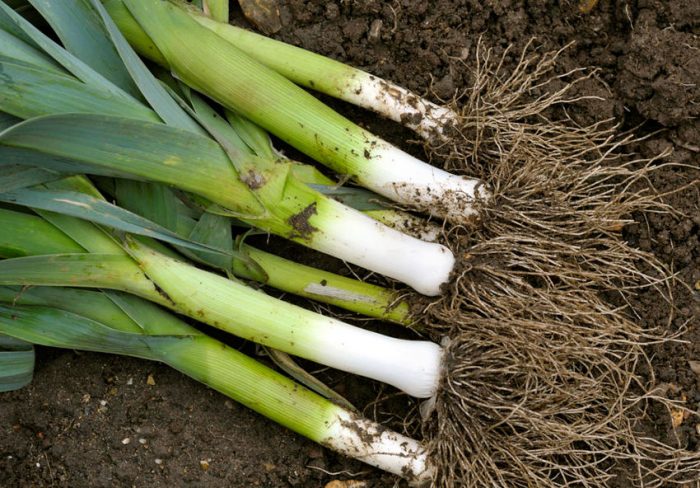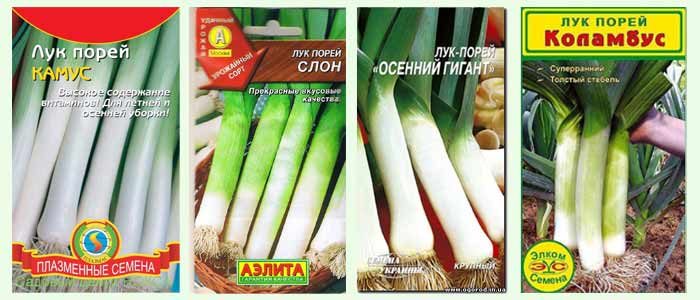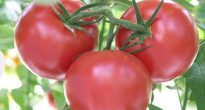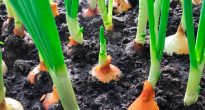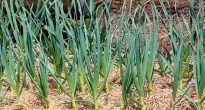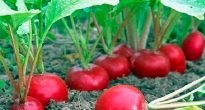The herb leek (Allium porrum), also called the pearl onion, is a member of the genus Onion. His homeland is Western Asia, a little later he ended up on the territory of the Mediterranean, and today, in natural conditions, you can meet grape onions, which is the original wild-growing form of this vegetable. Such onions were widely grown in the countries of the ancient world (Rome, Egypt and Greece); in the Middle Ages, they began to cultivate it throughout the entire European territory. This plant is especially popular with the French, so Anatoly France called leek asparagus for the poor. Today this onion is cultivated in almost all countries.
Content
Brief description of cultivation
- Landing... Sowing seeds in open soil is carried out in November before winter, and they are sown for seedlings in the last days of February or the first in March. They are sown in the greenhouse in mid-April, and under the film - in the last days of April. Seedlings are planted in open soil in the first half of May.
- Illumination... Needs lots of bright sunlight.
- Priming... The ground should be nutritious, breathable and neutral.
- Watering... It is necessary to water systematically. After the seedlings are transplanted to the site, they are not watered for several days. Then watering is carried out on average 1 time in 5 days, while 1–1.5 buckets of water are taken per 1 square meter of the plot.
- Fertilizer... During the season, leeks require 3 or 4 feeding, for this they use mineral fertilizers and organic matter. The first fertilization is carried out 20 days after planting seedlings in the garden. From mid-summer until the end of the growing season, the bushes will need to be spud 3 or 4 times, this procedure is mandatory for such a plant.
- Reproduction... Seed.
- Harmful insects... Onion flies.
- Diseases... Rust, peronosporosis, viral mosaic.
- Properties... Such onions are classified as dietary plants; they also have medicinal properties.
Features of leeks
The leek is a herbaceous biennial plant that can vary in height from 0.4 to 1 m.In the first year of growth, this culture forms a powerful root system, a white false bulb, which is 10–12 centimeters long and 2–8 centimeters in diameter, then it transforms into a false stem and many greenish-blue or green leaf plates arranged in a fan and having a linear-lanceolate shape. During the second season, a two-meter peduncle is formed in the bushes, on which an umbrella grows, consisting of white or pink flowers, this is observed in June-July, and in August-September the seeds ripen, which remain viable for 2 years, outwardly they are similar with onion seeds.
This onion is a moisture-loving and frost-resistant plant. In the northern and central regions, it is grown through seedlings, while in the southern regions, sowing is carried out directly into open soil.
Growing leeks from seeds
Sowing seedlings
The vegetation period of leeks lasts 150-200 days. To speed up the ripening process, it is grown through seedlings. Sowing seeds for seedlings in room conditions is recommended to be carried out in the last days of February or the first - in March. In mid-April, seeds are sown in a greenhouse, and in open ground under a film - in the last days of April.
Before proceeding with sowing indoors, you need to prepare dishes, the depth of which should be at least 10-12 centimeters, since this plant has long roots. Individual cups or pots are best suited for sowing. The container is washed with a strong solution of potassium permanganate for disinfection purposes. Then the seed is placed for several hours in a thermos filled with lukewarm water (from 40 to 45 degrees). The seeds taken out of the thermos are immediately immersed in cold water, and then they are laid out on a piece of cloth or paper sheet, they should dry out to a loose state. The selected container is filled with a light sod-humus substrate, which is slightly compacted. Then the seeds are sown, which are sprinkled on top with a half centimeter layer of sand. The dishes from above must be covered with glass (film) and transferred to a warm place (from 22 to 25 degrees), where the crops will stay before the first seedlings appear.
Growing seedlings
Every day, the crops need to be ventilated. Make sure that the substrate is constantly slightly damp, for this it is systematically sprayed from a spray bottle. After 1.5 weeks after sowing, the first seedlings should appear. Immediately after this, the shelter is removed from the containers, and the plants are transferred to a well-lit (light should be diffused) place. The temperature regime at this time should be as follows: in the daytime - from 18 to 20 degrees, and at night - from 12 to 14 degrees.
The root system of the bushes must be protected from hypothermia, therefore, under the pots that stand on the windowsill, you must put a sheet of foam or drywall. Also, seedlings can be damaged by drafts and scorching direct rays of the sun. Excessively dense seedlings must be thinned out. Lukewarm water is used for watering them. The hardened grown plants are fed with a nutrient mixture consisting of 10 liters of water, 20 grams of potassium chloride, 40 grams of superphosphate and 20 grams of ammonium nitrate per 1 square meter of crops.
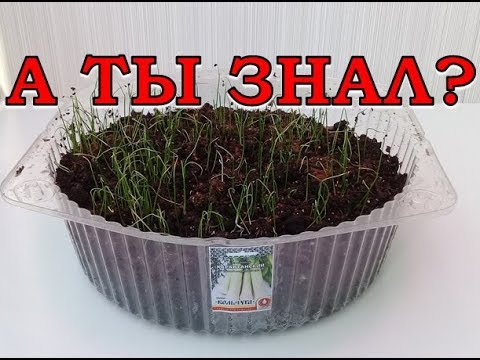

Watch this video on YouTube
Planting leeks outdoors
What time to plant
Leek seedlings are planted in open ground in the first half of May, the age of the seedlings at the moment should reach 50-60 days. Immediately before planting seedlings in the garden, they must be watered abundantly. And during the transplant itself, the roots and foliage are shortened by 1/3 of the plants. It is recommended to plant seedlings on a cloudy day or in the evening.
Suitable soil
A well-lit open area is suitable for growing such a crop, which is not shaded by trees or buildings. The soil should be neutral, nutritious and well-drained.Excessively acidic soil must be corrected by liming. The preparation of the site should be done in the autumn, for this it is dug up, while simultaneously introducing 1 tsp into the soil. urea, 2 tbsp. l. Nitrophoska and 10 liters of humus or compost per 1 square meter of the garden. In spring, humus and compost are scattered over the surface of the site (3 kilograms per 1 square meter), but no digging is carried out, this organic matter will get into the soil during planting of seedlings and due to watering. After this preparation, seedlings can be planted.
The best predecessors of this crop are: beans, peas, soybeans and other legumes, white cabbage, early-ripening potatoes, green manure and tomatoes. The area where any type of onion has been grown for the last 3 years is not suitable for planting this crop.
Landing rules
Seedlings begin to harden at the age of 6-7 weeks; for this, they are transferred outside during the daytime. The duration of such procedures is increased gradually, starting from several hours. When the plants are hardened, they can be planted in open soil.
Level the surface of the prepared area and make deep (from 10 to 15 centimeters) grooves, while the row spacing should be from 0.2 to 0.3 m. The soil pulled from the groove is laid in such a way that it cannot crumble into it. Depending on the variety, when planting plants, a distance of 10 to 25 centimeters is observed between them. During the planting of seedlings, their roots are cut to 40 mm, and then they are dipped in a chatter box, which includes cow dung, clay and water (1: 1: 1). The onion is only slightly dripped in the groove (it is not necessary to completely fill it up). The planted plants need abundant watering, after which there should be no voids around the root system.


Watch this video on YouTube
Winter sowing
Podzimny sowing of leeks is also very popular with gardeners. The preparation of the site is carried out in the summer months, for this they are digging, during which the necessary fertilizers are introduced into the ground. Sowing seeds is carried out in November in prepared grooves, keeping the distance between them from 8 to 12 centimeters. In this case, the row spacing should be about 20 centimeters. For sowing, it is necessary to choose a time when there will definitely not be any warming, since the seedlings that appeared in warm weather can then die at the first frost. The surface of the bed must be covered with a layer of mulch (humus or peat), and then it is covered with a layer of snow, and the thicker it is, the better. When the snow cover completely disappears in spring, the first shoots will appear, by this time the return frosts should have already passed.
Leek care
Growing leeks in your garden is easy enough. Such a plant must be timely watered, weeded, fed, loosened the soil surface in the aisles, and, if necessary, protected from harmful insects and diseases. And in order to get bleached stems, for which leeks are valued, the bushes will have to be spud 3 or 4 times during the season. The first hilling is carried out in the middle of the summer period. Each time the bushes are huddled, the surface of the bed must be covered with a layer of mulch (dry grass, chopped straw or dry manure).
Experts advise to loosen the soil in the aisles at least 1 time in half a month. After the thickness of the stem of the bushes is equal to the diameter of the pencil, it is necessary to begin to gradually add to the grooves the soil that was removed from them during preparation for planting, do this simultaneously with loosening. Immediately after the grooves are completely closed, the first hilling should be carried out.
Watering
Such a culture is moisture-loving. But the first three days after planting the seedlings in the soil, they should not be watered. Then, on average, the bushes are watered once every 5 days, while 1–1.5 buckets of water should be consumed per 1 square meter of the plot, which must be warm.
Fertilizer
Throughout the growing season, the bushes need to be fed 3 or 4 times.When 20 days have passed after planting seedlings in open soil, it should be fed for the first time, for this use a nutrient solution consisting of ½ a bucket of water, 7.5 grams of potassium salt and 10 grams of ammonium nitrate (this mixture is enough for 2 square meters of beds) ... This plant can also be fed with organic matter, namely: a solution of bird droppings (1:20) or mullein (1:10). Before starting hilling, wood ash must be poured under each leek stalk (1 tbsp per 1 square meter of the garden bed). This must be done before each hilling.
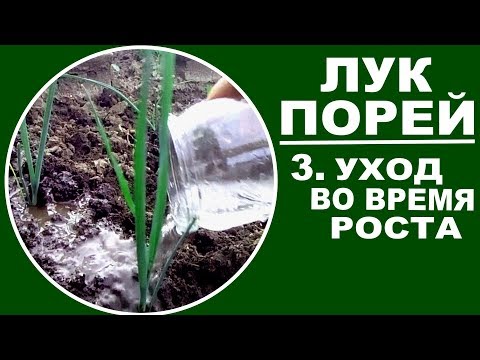

Watch this video on YouTube
Leek pests and diseases
Diseases
Of all the diseases, the greatest danger to leeks is mosaic. It is a viral disease and its main carrier is aphids. You can understand that the bushes are affected by the mosaic by the yellow longitudinally located spots on the leaf plates. In diseased bushes, growth retardation is observed.
Such onions can also infect fungal diseases, namely, rust and downy mildew (peronosporosis). On the foliage of bushes affected by peronosporosis, oval-shaped specks are formed, which quickly increase in size. Diseased plants should not be eaten. If the leek is affected by rust, then on the surface of its leaf plates pads of spores of the fungus of a rich yellow color are formed. Over time, the pads become darker and then black, while the affected foliage will die off.
Harmful insects
The onion fly can harm such a plant most of all. It can kill most of the crop. The onion fly appears already in mid-May, at which time it arranges egg-laying on the surface of leek foliage and in the ground. Two days later, larvae hatch from the eggs, which eat up the central part of the bush, which is why rot appears on it, and it begins to fade.
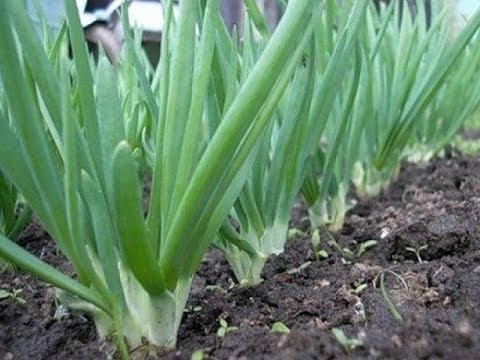

Watch this video on YouTube
Leek processing
In order to prevent an onion fly from appearing on the garden bed, it is powdered with wood ash (per 1 square meter of a plot of 1 tbsp.). The ash can be replaced with tobacco dust, or the dust is combined with ash. You can also scare off such a pest with ground pepper, which is used to treat the surface of the soil (for 1 square meter of the plot, 1 tsp). After pollination is completed, the soil surface must be loosened to a depth of 20 to 30 mm, it does not matter what exactly you choose for processing. The infusion of tobacco does an excellent job with the onion fly, for its preparation you need to combine 1 bucket of hot water, 0.2 kg of tobacco and 1 tbsp. l. any liquid soap. After a few hours, the infusion will be ready, it will only be necessary to strain it and you can start processing the bushes. In order to prevent the appearance of such a harmful insect on the site, experienced gardeners advise planting celery in the aisles.
Shrubs and the surface of the soil in the garden bed with fungal disease should be treated with a solution of copper oxychloride or Fitosporin. To date, no effective drugs have been found for viral diseases, so it is so important to adhere to preventive measures:
- remember the rules of crop rotation;
- timely remove weed from the site and fight pests;
- be sure to disinfect the seed before sowing;
- dig up and destroy diseased bushes immediately after they are found;
- for cultivation, choose varieties resistant to viral diseases.
Harvesting and storage of leeks
Harvesting leeks should be carried out before the air temperature on the site drops to minus 5 degrees.The fact is that this type of onion can withstand frosts only up to minus 7 degrees. Use a shovel to remove the plants from the ground and fold them over the edge of the groove so that they can dry out. After that, the remains of the soil are carefully removed from the bushes, while trying not to get it between the leaf plates. Then the roots are slightly trimmed and the leek is removed for storage. Remember that the leaves should not be cut from the onion, as this will cause it to wilt as soon as possible.
Such a vegetable is stored in various ways.For example, it can be removed to the cellar, while the air temperature should be from minus 1 degrees to plus 1 degrees, and the air humidity should be about 85 percent. Take a box and put a five-centimeter layer of wet river sand on its bottom. Then leek stems are placed vertically in it, and the voids between them are filled with sand. In the cellar, such a vegetable can be stored for about 6 months. Also, the onion, laid in a box with sand, can be placed on the balcony for storage, cover it well, and it will not be afraid of frosts down to minus 7 degrees.
You can store this vegetable in the refrigerator. To do this, choose the highest quality leek, shorten its foliage and roots, and then cool it to 0 degrees. Then the onion is taken out and immediately folded into perforated polyethylene bags of 6-8 stalks. Then they are placed on a refrigerator shelf and stored for four to five months at an air temperature of about minus 5 degrees. You can also rinse the leek, cut it into pieces and put them in bags with a layer of about 50 mm, then they are placed in storage in the freezer.


Watch this video on YouTube
Types and varieties of leeks
All varieties of leeks are divided by ripening periods into summer (early ripening), harvesting is carried out in August or in the first days of September, autumn (medium ripening), the vegetable ripens by October, and also winter (late ripening).
Early maturing varieties
Early maturing varieties ripen in 130–150 days, the weight of their legs varies from 0.2 to 0.35 kg, and they reach 30 mm in diameter. In such varieties, the foliage is green and narrow, it is placed on a false stem at an acute angle, while by the last days of July they become rough. The following varieties are most popular with gardeners:
- Columbus... This variety is one of the best early maturing varieties, it was created by breeders from Holland. This leek has a high taste. The height of an adult bush is about 0.7–0.8 m, the length of its legs is about 20 centimeters, it reaches 60 mm in diameter, and it weighs an average of 0.4 kg. This variety is good because it does not need to be hilled in order to bleach the stem.
- Vesta... This fruitful variety has a bushes height of about one and a half meters. Moreover, if you regularly spud the grocery stalk, then its height can be about 0.3 m, and it can weigh about 0.35 kg. This onion is very tasty and has a sweetish taste.
- Elephant's trunk... Due to the frequent hilling, the leg height of such a plant can reach 0.3 m. This plant is suitable for long-term storage and it has a wonderful sweetish taste.
- Goliath... The height of the bleached part can reach about 0.3 m, in diameter it reaches up to 60 mm, and weighs about 0.2 kg. The bulb is poorly expressed, and the wide leaf plates have a green-grayish or green color.
- Kilima... This mid-early variety has a high yield. The height of the bleached part of the plant is 10-25 centimeters, in diameter it reaches from 30 to 40 mm, and weighs about 150 grams.
Mid-season varieties
Compared to early-ripening varieties of medium ripening, they have a lower yield, but they are of higher quality. The ripening period of such varieties is 150–180 days. Their green-bluish leaf plates are about 70 mm wide, the legs are about 25 centimeters high, and their average weight is 0.2 kg. The best varieties in this group:
- Jolant... This variety is distinguished by its yield and resistance to fungal diseases. The height of the leg is about 0.35 m, the bulb is weakly expressed, the leaf plates are grooved and narrow, dark green with an anthocyanin shade, they are located vertically.
- Casimir... Such a tall variety is compact, productive and resistant to fungal diseases. Leaf plates extend from the stem almost vertically, the height of the bleached part of the stem is about 0.25 m, while it reaches 35 mm in diameter.
- Camus... The variety is resistant to fungal diseases. The height of the bush is average, on the surface of the green concave leaf plates there is a small coating of wax, the bulb is poorly expressed. The height of the bleached stem is about 0.2 m, and in diameter it reaches up to 25 mm.
- Tango... The variety is high-yielding and winter-hardy. The leaf plates are located almost vertically, the bulb is poorly expressed. The height of the bleached stem is about 12 centimeters, it reaches 50 mm in diameter, and the average weight is 0.22 kg.


Watch this video on YouTube
Late-ripening varieties
Ripening of late-ripening varieties lasts more than 180 days. They have the same yield as medium-ripening varieties, but they can be stored longer. On the surface of bluish-green wide leaf plates, there is often a coating of wax. On the false stem, they are placed very tightly and depart from it almost at a right angle, which makes the bush look squat. The thick and dense leg is relatively short. The most popular varieties are:
- Karantansky... The length of the bleached leg of such a plant is about 0.25 m, and in diameter it reaches only 40 mm, while it can weigh 0.2 kg or more. Dark green, spreading, wide leaf plates have a strong coating of wax on the surface.
- Elephant. This variety was created by Czech breeders, it has a slightly pungent taste, and it is also resistant to frost and drought. The leg is about 0.25 m long and weighs about 0.2 kg. The bulb is weakly expressed, there is a strong coating of wax on the surface of the greenish-blue leaf plates.
- Bandit... This is a frost-hardy, vigorous and spectacular Dutch plant, with a tasty bleached stem, thick and short.
- Autumn giant... This variety was also born thanks to Dutch breeders, its advantage is that it has an excellent keeping quality. The height of a large bleached leg can be up to 0.4 m, and it reaches about 80 mm in diameter.
- Asgeos... In this frost-resistant variety, the bulb is weakly expressed, dark wide leaf plates have a green-bluish color. The taste of the bleached leg is semi-sharp, its height is about 0.2 m, and it weighs about 0.35 kg.
- Mercury... Such a plant is resistant to viral diseases. The leaf plates are dark green. The taste of the bleached leg is semi-sharp, its height is about 0.25 m, and it weighs up to 0.2 kg.
Leek properties: harm and benefit
Useful properties of leeks
Leek contains a large amount of vitamins (B2, B1, E, C), carotene, as well as protein substances, salts of potassium, magnesium, iron, phosphorus, calcium and sulfur. During storage, the amount of ascorbic acid increases by more than 1.5 times.
Since ancient times, people have known that such a plant has medicinal properties. It is used in the treatment of gout, scurvy, rheumatism, obesity, metabolic disorders, vitamin deficiency, exhaustion, urolithiasis, and mental and physical fatigue. During clinical studies, experts have found that leek has a diuretic and choleretic effect, and also helps to improve liver function and increase appetite. This onion is also used to slow the progression of cancer, for example, in cancer of the prostate, intestines and uterus. In addition, such a vegetable helps to restore the body, tones it up and energizes it during spring beriberi. It is also used for the rapid healing of scratches and abrasions, to increase the amount of hemoglobin in the blood, as well as in the treatment of tuberculosis and anthrax, streptococcal and staphylococcal infections, diarrhea, insomnia, chills, asthma attacks, arthritis and other diseases and disorders of the body.
This vegetable has a very low calorie content, therefore it is classified as a dietary product. Therefore, nutritionists advise that it is eaten by those who follow the figure or want to get rid of excess weight. Leeks are used for making borscht, mashed soups, pickles, and also added to omelet, salads, vegetable stew, casseroles and pizza.Stewed onion with lemon dressing is an excellent side dish.


Watch this video on YouTube
Contraindications
For diseases of the duodenum and stomach, it is not recommended to eat fresh leek. However, after heat treatment, this onion will not harm you for such diseases. Do not eat leeks for diseases of the bladder and kidneys. For those who have kidney stones, this vegetable should be eaten with caution, since it contains the substance oxalite. Eating too much leeks can cause severe headaches.

